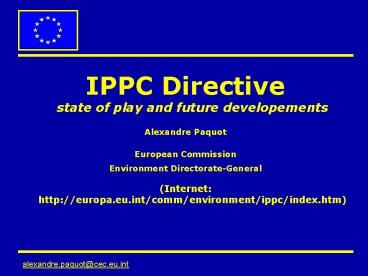IPPC Directive state of play and future developements PowerPoint PPT Presentation
1 / 14
Title: IPPC Directive state of play and future developements
1
- IPPC Directivestate of play and future
developements - Alexandre Paquot
- European Commission
- Environment Directorate-General
- (Internet http//europa.eu.int/comm/environment/i
ppc/index.htm)
2
Future milestones
Commission reports on implementation of Directive
MS implemen-tation reportsto be submitted
Adoption of IPPC Communica-tion
Jan 2003
June 2003
Sep 2006
June 2007
June 2004
Sep 2003
May 2004
Oct 2007
Jan 2005
June 2005
Dec 2005
Amendmentallowing green-house gasemission
tradingcomes in effect
Enlargement
Amendment strengtheningpublic partici-pation
comesin effect
Firstedition of all BREFsshould beready
Latest com-pliance datefor existinginstallation
s
3
The first national reports (1)
- Some preliminary conclusions
- Directive has been adequately transposed in most
Member States - Implementation has been slow in some of them,
particularly in those without prior experience in
integrated environmental permitting
4
The first national reports (2)
- Problems common to several Member States
- Legal requirements on reconsideration and
updating of permits - Disproportionate number of applications may have
to be be filed immediately prior to the October
2007 deadline - No transboundary cooperation in permit procedures
5
The first national reports (3)
- Views on IPPC
- Effective tool in combating pollution by
industrial installations - Administrative simplification
- Fosters dialogue between the authorities and
industry - Flexibility allowed in the actual implementation
- Wish for greater uniformity and technical
coherence with other EU legislation
6
- June 03 Communication on IPPC
COM(2003) 354 http//europa.eu.int/comm/environme
nt/ippc/index.htm Why a Communication?
- stress the importance of IPPC
- insufficient progress
- key interpretation issues
- launch consultation
7
Keys conclusions of consultation on the
Communication
- Concern about the October 2007 deadline
- General support of the IPPC Directive no call
for radical changes - Unanimous call for guidance documents
- Call for technical review for clarification of
certain provision (in particular the scope) - Possibility to use emissions trading instruments
(NL, UK, certain industries) / creating more
incentives - Assess the coherence with other legislations
- More user-friendly BREFs
8
From BREF to Permit condition
Descriptive
MS right to choose how
Legally binding
9
BAT Information Exchange
- required by Directive (Art 16 paragraph 2)
- purpose to support licensing authorities
- published BAT Reference Documents (BREFs) for
each sector - BREFs should be taken into account by the
licensing authorities
10
Finalised BREFs
- Iron and steel production
- Cement and lime production
- Non ferrous metals processing
- Pulp and paper production
- Glass production
- Ferrous metal processing
- Cooling systems
- Chlor-Alkali production
- Tanning of hides and skins
- Large-Volume Organic Chemicals production
- Waste water and waste gas treatment in the
chemical industry - Refining of mineral oil
- Textile industry
- Pig and poultry farming
- Principles of monitoring
- Slaughterhouses and animal by-products()
- Smitheries and foundries()
- (Management of mining waste)()
11
Ongoing BREFs
- Economic and cross-media issues
- Food, drink and milk processes
- Large combustion plant
- Emissions from storage
- Waste treatments
- Waste incineration
- Ammonia, acids and fertilizers
- Surface treatment of metals
- Surface treatment using solvents
- Organic fine chemicals
- Other large-volume inorganic chemicals
- Speciality inorganic chemicals
- Ceramics
- Polymers
12
Next BREF phase
- 2004-2006
- Energy efficiency
- Cement and lime production
- Iron and steel production
- 2005-2007
- Pulp and paper production
- Ferrous metal processing
- Glass production
- Tanning of hides and skins
- Non ferrous metals processing
- 2006-2012
- More revisions
- New sectors?
13
Concluding remarks (1)
- Flexible, goal-setting legislation opportunity
for environment industry - Heavily dependent on good faith (on behalf of
industry operators and authorities) - Complements other instruments (EQS-based,
voluntary / market-based, economic instruments) - High level of protection of the environment
14
Concluding remarks (2)
- Integrated approach by industry operators and
authorities - Application of Best Available Techniques
- Provides framework for further and better
regulation where necessary - No short term review (2005) of the Directive

